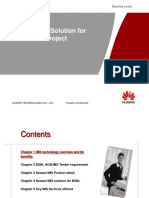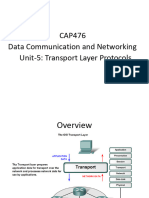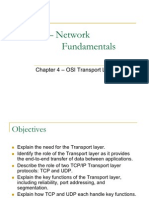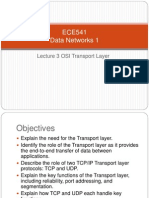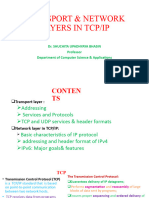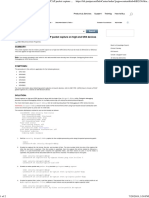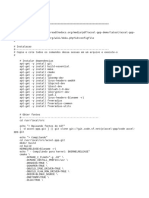0 ratings0% found this document useful (0 votes)
13 viewsTransport Layer Protocol
Transport Layer Protocol
Uploaded by
Taste And FoodTCP provides reliable data transmission through mechanisms like positive acknowledgment and retransmission of lost packets. It is a connection-oriented protocol that establishes logical connections between endpoints using a three-way handshake. TCP delivers data as a continuous byte stream and ensures packets are delivered accurately and in order. UDP is an unreliable, connectionless protocol that provides simple datagram delivery without acknowledgments or guaranteed ordering.
Copyright:
© All Rights Reserved
Available Formats
Download as PPTX, PDF, TXT or read online from Scribd
Transport Layer Protocol
Transport Layer Protocol
Uploaded by
Taste And Food0 ratings0% found this document useful (0 votes)
13 views11 pagesTCP provides reliable data transmission through mechanisms like positive acknowledgment and retransmission of lost packets. It is a connection-oriented protocol that establishes logical connections between endpoints using a three-way handshake. TCP delivers data as a continuous byte stream and ensures packets are delivered accurately and in order. UDP is an unreliable, connectionless protocol that provides simple datagram delivery without acknowledgments or guaranteed ordering.
Original Description:
Transmission control protocol
Original Title
TCP
Copyright
© © All Rights Reserved
Available Formats
PPTX, PDF, TXT or read online from Scribd
Share this document
Did you find this document useful?
Is this content inappropriate?
TCP provides reliable data transmission through mechanisms like positive acknowledgment and retransmission of lost packets. It is a connection-oriented protocol that establishes logical connections between endpoints using a three-way handshake. TCP delivers data as a continuous byte stream and ensures packets are delivered accurately and in order. UDP is an unreliable, connectionless protocol that provides simple datagram delivery without acknowledgments or guaranteed ordering.
Copyright:
© All Rights Reserved
Available Formats
Download as PPTX, PDF, TXT or read online from Scribd
Download as pptx, pdf, or txt
0 ratings0% found this document useful (0 votes)
13 views11 pagesTransport Layer Protocol
Transport Layer Protocol
Uploaded by
Taste And FoodTCP provides reliable data transmission through mechanisms like positive acknowledgment and retransmission of lost packets. It is a connection-oriented protocol that establishes logical connections between endpoints using a three-way handshake. TCP delivers data as a continuous byte stream and ensures packets are delivered accurately and in order. UDP is an unreliable, connectionless protocol that provides simple datagram delivery without acknowledgments or guaranteed ordering.
Copyright:
© All Rights Reserved
Available Formats
Download as PPTX, PDF, TXT or read online from Scribd
Download as pptx, pdf, or txt
You are on page 1of 11
TCP
Transport Layer Protocol
Transport Layer
• The protocol layer just above the Internet Layer is
the Host-to-Host Transport Layer.
• This name is usually shortened to Transport Layer.
The two most important protocols in the Transport
Layer are Transmission Control Protocol
(TCP) and User Datagram Protocol (UDP).
Transport Layer
• TCP provides reliable data delivery service with end-to-end error detection
and correction. UDP provides low-overhead, connectionless datagram
delivery service.
• Both protocols deliver data between the Application Layer and the
Internet Layer. Applications programmers can choose whichever service is
more appropriate for their specific applications.
User Datagram Protocol
• The User Datagram Protocol gives application programs direct
access to a datagram delivery service, like the delivery service
that IP provides. This allows applications to exchange
messages over the network with a minimum of protocol
overhead.
UDP
• UDP is an unreliable, connectionless datagram protocol. As noted
previously, unreliable merely means that there are no techniques in the
protocol for verifying that the data reached the other end of the network
correctly.
• Within your computer, UDP will deliver data correctly. UDP uses 16-
bit Source Port and Destination Port numbers in word 1 of the message
header, to deliver data to the correct applications process. Figure shows
the UDP message format.
Transmission Control Protocol
• Applications that require the transport protocol to provide
reliable data delivery use TCP because it verifies that data is
delivered across the network accurately and in the proper
sequence.
• TCP is a reliable, connection-oriented, byte-stream protocol.
Let’s look at each of the terms—reliable, connection-oriented,
and byte-stream—in more detail.
• TCP provides reliability with a mechanism called Positive Acknowledgment with Re-
transmission (PAR). Simply stated, a system using PAR sends the data again, unless
it hears from the remote system that the data arrived successfully. The unit of data
exchanged between cooperating TCP modules is called a segment (see Figure).
• Each segment contains a checksum that the recipient uses to verify that the data
is undamaged. If the data segment is received undamaged, the receiver sends
a positive acknowledgment back to the sender. If the data segment is damaged,
the receiver discards it. After an appropriate time-out period, the sending TCP
module re-transmits any segment for which no positive acknowledgment has been
received.
Let’s look at each of the terms—reliable, connection-oriented,
and byte-stream—in more detail.
• TCP is connection-oriented. It establishes a logical end-to-end connection
between the two communicating hosts. Control information, called
a handshake, is exchanged between the two endpoints to establish a
dialogue before data is transmitted. TCP indicates the control function of a
segment by setting the appropriate bit in the Flags field in word 4 of
the segment header.
• The type of handshake used by TCP is called a three-way
handshake because three segments are exchanged.
• Host A begins the connection by sending host B a segment with the Synchronize
sequence numbers (SYN) bit set. This segment tells host B that A wishes to set up a
connection, and it tells B what sequence number host A will use as a starting
number for its segments. (Sequence numbers are used to keep data in the proper
order.)
• Host B responds to A with a segment that has the Acknowledgment (ACK) and SYN
bits set. B’s segment acknowledges the receipt of A’s segment, and
informs A which Sequence Number host B will start with. Finally, host A sends a
segment that acknowledges receipt of B’s segment, and transfers the first actual
data.
You might also like
- A10 Configuring Application Delivery PartitionsDocument46 pagesA10 Configuring Application Delivery PartitionsNguyen AnhNo ratings yet
- Cisco Umbrella: First Line of Defense For Threats On The InternetDocument149 pagesCisco Umbrella: First Line of Defense For Threats On The Internetmemo_fdzsNo ratings yet
- ScaN Skills Assess - EIGRP - Student TRNG - ExamDocument16 pagesScaN Skills Assess - EIGRP - Student TRNG - Examchristian318_810% (10)
- Huawei IMS SolutionDocument40 pagesHuawei IMS SolutionRavi Chaurasia71% (7)
- 202003291621085570shruti Saxena Engg COMPUTER NETWORK 3Document15 pages202003291621085570shruti Saxena Engg COMPUTER NETWORK 3ppawah04No ratings yet
- ACN Unit - 4 NotesDocument17 pagesACN Unit - 4 NotesKrishna HundaniNo ratings yet
- CN Unit 4Document59 pagesCN Unit 4rahulnr052020No ratings yet
- Transport LayerDocument9 pagesTransport Layersahumitali2005No ratings yet
- CN UNIT 4 Transport LayerDocument32 pagesCN UNIT 4 Transport Layerharsharewards1No ratings yet
- Muhammad Ahmad TCP CYBEROPSDocument22 pagesMuhammad Ahmad TCP CYBEROPSmuhammad ahmadNo ratings yet
- CN Unit-5 MaterialDocument27 pagesCN Unit-5 MaterialsuneelkluNo ratings yet
- CN - Unit4.1Document50 pagesCN - Unit4.1Nishant BHARDWAJNo ratings yet
- Chapter 4 TransportLayerDocument44 pagesChapter 4 TransportLayerSebunya RonaldoNo ratings yet
- TCP ProtocalDocument30 pagesTCP ProtocalNaresh PatnanaNo ratings yet
- Transport LayerDocument51 pagesTransport LayerSsemakula FrankNo ratings yet
- Lecture 28 - Transport Layer Protocols-Joel-PcDocument80 pagesLecture 28 - Transport Layer Protocols-Joel-PcjoelanandrajNo ratings yet
- UNIT 4 ACN UpdatedDocument68 pagesUNIT 4 ACN UpdatedagasyabutoliaNo ratings yet
- (TCP) Transmission Control Protocol (TCP) - Header, Definition - JavatpointDocument7 pages(TCP) Transmission Control Protocol (TCP) - Header, Definition - JavatpointMkt RayNo ratings yet
- 4.1 TCP & UDPDocument59 pages4.1 TCP & UDPkatyaini1511No ratings yet
- CN Unit 5 Computer Network NotesDocument33 pagesCN Unit 5 Computer Network Notesgdsc.pragatiNo ratings yet
- UDP and TCP NotesDocument5 pagesUDP and TCP NotesharshvardhansutarNo ratings yet
- Transport Layer CNDocument24 pagesTransport Layer CNYuvaraj GoudarNo ratings yet
- Transport Control ProtocolDocument11 pagesTransport Control ProtocolDenise EspantoNo ratings yet
- Client/Server Paradigm: Mod 4 Process-To-Process DeliveryDocument29 pagesClient/Server Paradigm: Mod 4 Process-To-Process DeliverySUREDDY TANUJA MSCS2018No ratings yet
- Transport LayerDocument22 pagesTransport Layeryadajyothsna04No ratings yet
- Chapter 4 Transport LayerDocument31 pagesChapter 4 Transport LayerTanu SrivastavaNo ratings yet
- Unit 10: Transport LayerDocument8 pagesUnit 10: Transport LayeryogeshdeoNo ratings yet
- Edited Unit 4 CN 4TH SemDocument8 pagesEdited Unit 4 CN 4TH Sempawanchourasia0329No ratings yet
- CN Unit4 NDocument30 pagesCN Unit4 NsaeuhsaoteuNo ratings yet
- Role of The Transport Layer: Tracking Individual ConversationsDocument5 pagesRole of The Transport Layer: Tracking Individual ConversationsAnonymous vWJXWUNo ratings yet
- List and explain transport layer protocolDocument4 pagesList and explain transport layer protocoldeveloperabhi596No ratings yet
- Lecture 11Document17 pagesLecture 11تُحف العقولNo ratings yet
- DCN-Unit IIDocument30 pagesDCN-Unit IIAmanNo ratings yet
- Unit IV (CN)Document12 pagesUnit IV (CN)Abdul RehamanNo ratings yet
- Network and Transport LayerDocument43 pagesNetwork and Transport Layerczan1030No ratings yet
- Computer Network Module - 3Document15 pagesComputer Network Module - 3ankitupadhyay2241No ratings yet
- Assignment 2Document9 pagesAssignment 2nohomaj999No ratings yet
- 02 Network Reference ModelDocument42 pages02 Network Reference Modelsamba amidou maîgaNo ratings yet
- 16 Unit-5 Transport Layer - ProtocolsDocument51 pages16 Unit-5 Transport Layer - Protocolsyogeshpati57No ratings yet
- TCP IpDocument16 pagesTCP Ipnithin_mampillyNo ratings yet
- Unit 4 IapDocument26 pagesUnit 4 Iapakhileshyadav0868787No ratings yet
- CN Unit-4Document30 pagesCN Unit-4SaiNo ratings yet
- CN Unit-II NotesDocument11 pagesCN Unit-II NotesJeeva ArumugamNo ratings yet
- CN Unit-Ii NotesDocument30 pagesCN Unit-Ii NotesJeeva ArumugamNo ratings yet
- 16 Unit5 Transport Layer ProtocolsDocument50 pages16 Unit5 Transport Layer Protocols20cs1a3122No ratings yet
- FT Lecture Notes 5 Transport Layer I Fall22Document9 pagesFT Lecture Notes 5 Transport Layer I Fall22woyecex875No ratings yet
- Jarkom M13Document18 pagesJarkom M13Royal DecreeNo ratings yet
- EC3401 NS UNIT 3 NOTES EduEnggDocument23 pagesEC3401 NS UNIT 3 NOTES EduEnggPriyadharshini KNo ratings yet
- ACN M2Document42 pagesACN M2emmanueldidymusNo ratings yet
- Transport Layer: Pawan Kumar Assistantprofessor Gjus&T, HisarDocument26 pagesTransport Layer: Pawan Kumar Assistantprofessor Gjus&T, HisarG100 -vishantNo ratings yet
- UNIT 4 CNDocument8 pagesUNIT 4 CNnishita patidarNo ratings yet
- DCN 5th UnitDocument12 pagesDCN 5th UnitNallani SireshaNo ratings yet
- Chapter-6 Transport Layer: 6.1 Services Provided To Upper LayerDocument6 pagesChapter-6 Transport Layer: 6.1 Services Provided To Upper LayerAmir SilwalNo ratings yet
- CN06-Transport LayerDocument42 pagesCN06-Transport LayerEmad Samir FarahatNo ratings yet
- CCNA Network Fundamentals - CH4Document37 pagesCCNA Network Fundamentals - CH4Lucelle MoralesNo ratings yet
- Transport LayerDocument26 pagesTransport LayerVaishali YadavNo ratings yet
- Day16 TransportLayerDocument13 pagesDay16 TransportLayerAshu ChauhanNo ratings yet
- Module 2Document91 pagesModule 2PALLAVI RNo ratings yet
- ECE541 Data Networks 1: Lecture 3 OSI Transport LayerDocument36 pagesECE541 Data Networks 1: Lecture 3 OSI Transport LayerUnicorn54No ratings yet
- Online Class TCPUDP IPDocument18 pagesOnline Class TCPUDP IPAshNo ratings yet
- Transport Layer ProtocolsDocument21 pagesTransport Layer ProtocolsSweta BarnwalNo ratings yet
- OSI Layer ProtocolsDocument11 pagesOSI Layer ProtocolsSoumajith DasNo ratings yet
- CHAPTER 5 Transport LayerDocument18 pagesCHAPTER 5 Transport LayerRani rajpurohitNo ratings yet
- Hacking Network Protocols: Unlocking the Secrets of Network Protocol AnalysisFrom EverandHacking Network Protocols: Unlocking the Secrets of Network Protocol AnalysisNo ratings yet
- Service Delivery Switch: Data SheetDocument5 pagesService Delivery Switch: Data SheetSujeet KumarNo ratings yet
- Http://d1.scribdassets - com/ScribdViewer - Swf?document Id 108992419&access Key Key-13davbcdewnewn9m5w02Document4 pagesHttp://d1.scribdassets - com/ScribdViewer - Swf?document Id 108992419&access Key Key-13davbcdewnewn9m5w02Dhoom Dhoom40% (5)
- HotSpot GatewayDocument20 pagesHotSpot Gatewaymatej_petek1No ratings yet
- Kamailio For Building An Ims Core For VolteDocument18 pagesKamailio For Building An Ims Core For VolteDxscribNo ratings yet
- Eswitching Chapter2: Ccna Exploration 3 Answers Chapter 2Document4 pagesEswitching Chapter2: Ccna Exploration 3 Answers Chapter 2JuliandersonPereiraNo ratings yet
- M416 HostingDocument63 pagesM416 HostingIisRamdhaniSubata100% (1)
- System Information Type 13Document3 pagesSystem Information Type 13ankitrimsNo ratings yet
- SNMP Datasheet For Ita Ups Sic snmp810Document2 pagesSNMP Datasheet For Ita Ups Sic snmp810Prashant JhaNo ratings yet
- Sicso Networking Academy Chapter 6 v5Document6 pagesSicso Networking Academy Chapter 6 v5Sopheap SangNo ratings yet
- Juniper Networks - (SRX) Example - Creating A PCAP Packet Capture On High-End SRX DevicesDocument2 pagesJuniper Networks - (SRX) Example - Creating A PCAP Packet Capture On High-End SRX Devicesravi kantNo ratings yet
- VTP Interview Questions and Answers (VLAN Trunking Protocol) - Networker InterviewDocument2 pagesVTP Interview Questions and Answers (VLAN Trunking Protocol) - Networker InterviewRahul Jaggi100% (1)
- MCIT Deployment Best Practice GuideDocument143 pagesMCIT Deployment Best Practice GuideProjekte AlbascanNo ratings yet
- ASA Firepower NGFW Typical Deployment ScenariosDocument114 pagesASA Firepower NGFW Typical Deployment ScenariosSébastien WeckeringNo ratings yet
- SyslogDocument2 pagesSyslogAnishNo ratings yet
- Accel PPPDocument46 pagesAccel PPPraphaelrrlNo ratings yet
- HP Network Adapter Scripting Utility User Guide: August 2006 (Fifteenth Edition) Part Number 289166-00PDocument21 pagesHP Network Adapter Scripting Utility User Guide: August 2006 (Fifteenth Edition) Part Number 289166-00PHan HuangNo ratings yet
- Huawei ICT Competition 2021-2022 Exam Outline - Network TrackDocument6 pagesHuawei ICT Competition 2021-2022 Exam Outline - Network TrackTHMEUR BENRAYANo ratings yet
- Port NumbersDocument76 pagesPort NumberssophiaNo ratings yet
- Quidway MA5200G System Overview and HardwareDocument51 pagesQuidway MA5200G System Overview and HardwareAbdelilah CharboubNo ratings yet
- Duplex and Speed Mismatch Demo (ICND1)Document4 pagesDuplex and Speed Mismatch Demo (ICND1)Bijay LamaNo ratings yet
- DCN 2021Document6 pagesDCN 2021MLLON DREAMSNo ratings yet
- CCN Lab 2Document8 pagesCCN Lab 2Mustafa Fazal AbbasNo ratings yet
- Manual Bdcom s2026Document3 pagesManual Bdcom s2026Mário SantosNo ratings yet
- 3 Wireshark TCP v6.0Document8 pages3 Wireshark TCP v6.0Trần Ngọc LâmNo ratings yet
- Muhammad Shan Anwer: ObjectiveDocument4 pagesMuhammad Shan Anwer: ObjectiveShan MalikNo ratings yet
- Aip W525HDocument2 pagesAip W525HSalvador MatNo ratings yet



